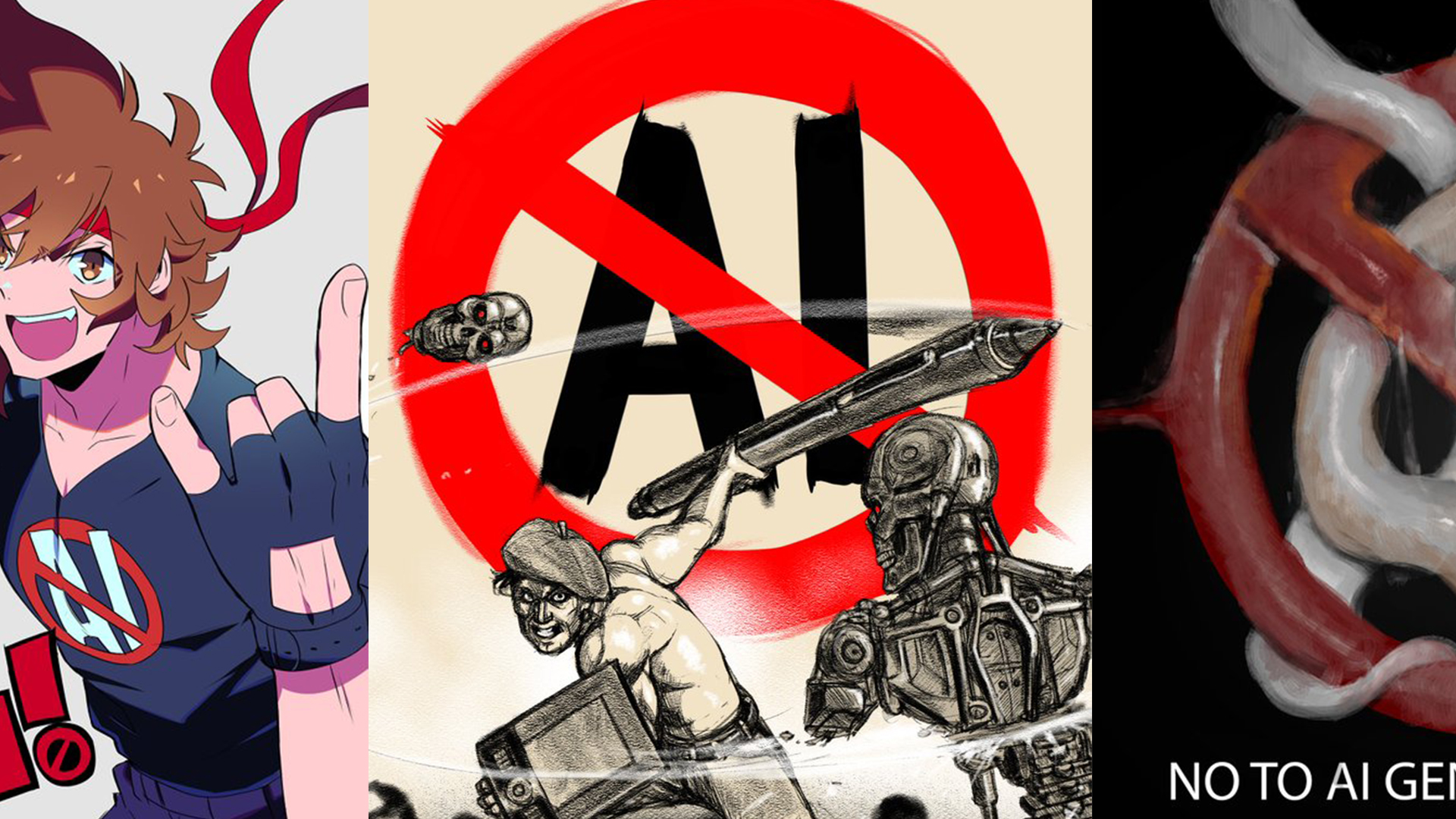Digital artists on social media and on platforms like ArtStation have launched a protest against the controversial AI art generation technology and its users. Artists are uploading images calling for the disuse of AI to generate images.

Some artists have gone a bit further, and are creating their own versions of the protest sign:
#notoai #notoaiart #notoaigeneratedimages #noaiart pic.twitter.com/UisI183WQ3
— Oleg Bulakh (@OlegBulakh_Art) December 16, 2022
[oc] NO TO AI GENERATED IMAGES 🚫 pic.twitter.com/z2uV7BjtDs
— 🔥 GUREPYON 🔥 commission grind!! (@GurepyonArt) December 16, 2022
SAY NO TO AI GENERATED IMAGES‼️🚫 quickly drew this since everyone else is doing it 😈 pic.twitter.com/AkyhInAbzN
— ✦ 𝐏𝐎𝐃𝐎𝐑𝐎 ✦ 🍉 #CeasefireNOW (@PodoroVines) December 17, 2022
BROTHERS EVERYWHERE
RAISE YOUR HANDS INTO THE AIR
WE'RE WARRIORS
WARRIORS OF THE WORLDSaw people where contributing their own artistic takes to the "Say No To AI Generated Images" and this popped into my head#HumanArtists #NoToAIGeneratedImages #NoToAIArt #artstation pic.twitter.com/fInec86LEl
— AnimatedAndrew (@CaffeineGiant) December 16, 2022
Many of the paintings poke fun at the fact that AI-generated images of people are unable to render hands and fingers properly.
But while it may seem like a creative way to release frustrated energy, the meteoric rise of AI art has genuinely raised serious concern among communities of digital artists, especially those that make a living off of their art.
Platforms that use AI and machine learning to scrape existing art and produce images are readily available, and easy to use. Stable Diffusion is among the more programmable and powerful of these, and it can produce detailed and authentic paintings completely free.

Human artists worry that these platforms will reduce their range of customers. Those that want digital paintings to be made, say for instance of themselves or of specific characters, can simply download applications like Stable Diffusion and do it themselves. No talent, no skill and no money involved.
Designers are also not safe from AI-generated images encroaching on their business. AI platforms like DALL-E-2 and Midjourney can produce mockups of UI design concepts.

While these mockups suffer from the same flaws as other AI images, they can be used to accelerate the initial phases of UI design. And the AI programmes that are running for these platforms are only going to improve the more they learn, and grow.
Eventually, platforms will be able to produce authentic, or near-authentic UI art, and companies will have to decide whether they want to hire five designers for a campaign or just one to choose which AI-generated UI looks best.
Artists face an uphill battle against AI-generated art as it extends past the creation of images.
Time recently covered the story of Ammaar Reshi, a product design manager, who by playing around with Midjourney and human-thought mimicking application ChatGPT managed to create a children’s book in a single weekend.
I spent the weekend playing with ChatGPT, MidJourney, and other AI tools… and by combining all of them, published a children’s book co-written and illustrated by AI!
Here’s how! 🧵 pic.twitter.com/0UjG2dxH7Q
— Ammaar Reshi (@ammaar) December 9, 2022
Reshi didn’t illustrate the images, and he “co-wrote” the book with the help of AI. He’s selling the book too, it’s titled Alice and Sparkle. It’s the first of its kind and it costs $8.99.
“Anyone can use these tools,” Reshi told Time. “It’s easily and readily accessible, and it’s not hard to use either.”
ChatGPT in particular is a formidable tool. We tested it to see if we could use it to write a high school essay for us, and we found that it was indeed possible after a bit of tinkering.
When in the hands of someone with coding knowledge, it becomes even more powerful. Twitter user Sharif Shameem claimed he built a UI layout generator using ChatGPT. One that generates Java Script XML code for you, so website designers can simply plug it in.
This is mind blowing.
With GPT-3, I built a layout generator where you just describe any layout you want, and it generates the JSX code for you.
W H A T pic.twitter.com/w8JkrZO4lk
— Sharif Shameem (@sharifshameem) July 13, 2020
There is no doubt that the power of these applications can make tasks so much easier, and faster. But the shadow of exploitation grows as these programmes expand their knowledge.
ChatGPT can be used to generate text for websites with very little effort. If you want to write a 300-word recipe for a new food item, you can do it. We envision micro-blogging sites using platforms like it to decrease article-writing time, but what does this mean for content or copywriters?
Imagine massive companies in China or Taiwan cutting costs by using easily generatable AI art en masse to create picture books or other products, or huge corporates not using artists at all because a powerful enough platform can do everything a team of designers or artists can in less time, with less costs and the work will be “good enough.”
All human artists can do is protest and increase awareness, but when it comes down to it people will choose free, fast and easy over costly, time-consuming and complex, especially when the end-product is nearly indistinguishable. Reshi hits the nail on the head when it comes to these platforms.
More will flock to them because of their ease of use and their power. It is up to those that care to defend human art against the machine.
[Image – @OlegBulakh_Art, @GurpyonArt, @CaffeineGiant on Twitter]

